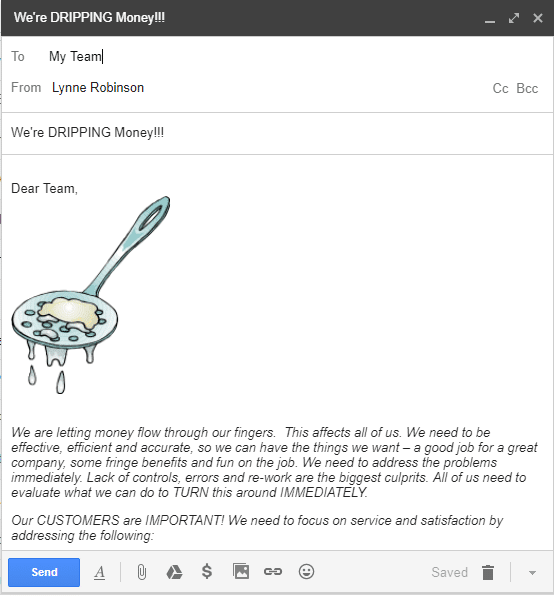The Wrong Way to Motivate Your Team
April 10, 2018 | People Management | No Comments

Does any of this sound familiar?
After working yourself into exhaustion, you finally have a eureka moment! You made a breakthrough discovery (or are completely fed up with a situation) and are about to implement a practice to improve jobs and company performance. You’re eager to get the ball rolling with your team.
But what’s the best way to share your findings with them? How do you strike the balance between motivating/encouraging and authoritative/directive?
Here is a perfect example of the wrong way to motivate your team (and what I learned from this experience).
It Started with a Memo
About 15 years ago, I sent a memo to my team. When I wrote it, I’d reached my maximum level of frustration. I was at my boiling point. I was angry – and it came across in my writing. While the content of the message was TRUE and necessary, in hindsight, this wasn’t the best approach. As my mother used to say it’s not what you say, it’s how you say it.
I’m sure as you read this, you’ll find the scenario and even the message familiar. No doubt, most business owners would come to the same conclusion I did in this situation, and resolution would require a similar initiative. The message had to be conveyed, however—THIS wasn’t the way to do it. (Although, I admit I do like the concept of “dripping money.”)
- Timely and accurate recording and processing of all transactions with a zero-error rate (everything done RIGHT the first time)
- Fine tune the system to meet the reporting and management needs (one data entry point and consistent, tied-down information – no variation depending on the source of the information)
- Paperless by the end of the year (all info in the computerized system – no need to go to the paper files)
- No lost money –
- We bill timely and accurately and pursue those who don’t pay (good business practices).
- We control our assets, especially equipment, inventory and accounts receivable (too much money is tied up, we can use it for other things)
- We resolve all issues timely to avoid “holding the bag” (absorbing costs that are not ours and/or creating unhappy customers).
- We know who is authorized to sign and have documented any verbal approvals (ability to collect and legally pursue our rights)
- Accountability (you will need to perform), increased sense of urgency (there are things that need to be done NOW) and balanced workload for ALL…
These goals EMERGED as the myriad of issues were identified. Not only did WE lose productivity and real revenue directly, WE spent an IMMENSE amount of money to find OUR mistakes, many of which remain uncorrected. This is a good business and there is NO REASON that we can’t make money and enjoy our jobs. We all have responsibility to move forward and meet the goals. While many of these issues have been improving over the last year — we are nowhere near where we need to be! Let’s start the New Year right – and focus on doing the RIGHT THINGS – RIGHT!”
I went on to give specific examples using the same tone, ALL CAPS and exclamation points. Not too effective.
A Little (or a Lot) Harsh, Right?
As they say, hindsight is 20/20. When I sent this email out, I didn’t receive the response I wanted. In fact, it actually had the opposite effect. My team was demotivated. They were upset, indignant and indifferent. Most of them skimmed through the message at best, probably rolled their eyes and went on with their day. In short, the message didn’t create the impact I was aiming for and we were all left more frustrated.
Throughout my years of running companies, both large and small, I learned many valuable lessons and universal truths. Many of them apply particularly well to communications standards we use in business:
- No Yelling. Writing in all caps reads as YELLING. It turns out, yelling and anger aren’t good motivators. No surprise here.
- No Beating a Dead Horse. No need to belabor the point. Bullet points are good, but keep emails short, concise and addressing one clear issue at a time.
- No Stating the Obvious. There’s no need to state the obvious, of course our customers are important. Of course, everyone wants to enjoy their job.
- No Ambiguity. Offer solutions, suggestions and a path for resolution. Use direct and clear language.
- No Drama. Err on the side of less drama. Sending out an email that’s the equivalent of running around and waving your arms in the air, just makes you seem hysterical and angry. Unless the building is on fire, there’s no need for theatrics.
- No Closing the Door. Employees often identify the problems, as they’re on the frontlines of your business. However, they will only bring them to your attention when there’s a clear process and a safe, open environment for doing so.
- No Dismissing Concerns and Resolutions. Your team is willing and able to help solve problems when they feel you listen to them and value their input.
- No Passing the Buck. Team members will rise to the occasion to hold themselves and the team accountable if there are clearly defined roles and responsibilities.
It won’t serve your interests to show your anger or frustration and it will break the trust of the team. Your message will at best fall flat or at worse go unnoticed.
Documenting processes and procedures, and creating clearly defined job responsibilities set the parameters for everyone. Foster a culture of trust and open communication to encourage motivation and team engagement. When everyone feels they have a hand in the game and a valuable role to play, they’ll jump on board.
Great leadership isn’t simply about ordering people to do a job, or identifying a problem to solve. Great leadership is about empowerment, listening and engagement with your employees. Allow them to share their feedback and praise them for their input. Create a dialogue rather than simply barking orders.
Address problems and concerns with a level head. Ask employees for their feedback and to help identify a path to the desired outcome. You may be surprised at the productivity and responsibility that emerge from a growth-friendly environment. As a business owner, you know problems are inevitable, it’s how they’re addressed that really makes a difference.
Check back for more great ways to ensure your team is invested in your company’s success!



